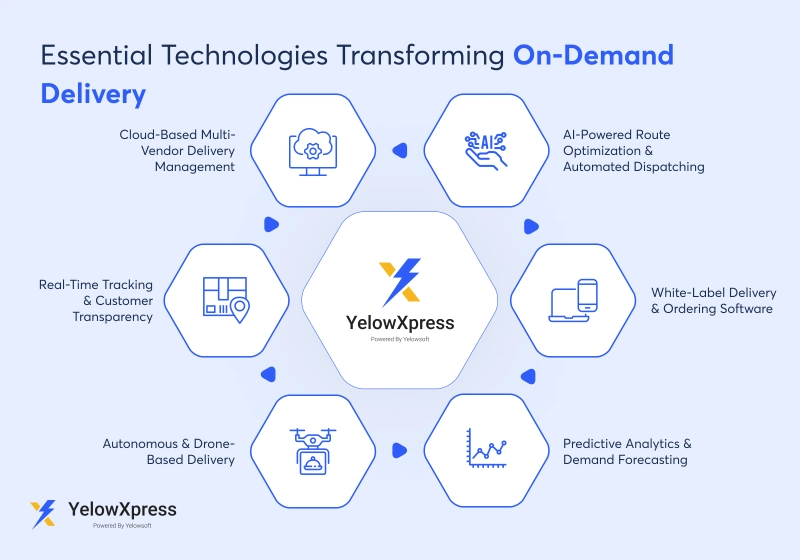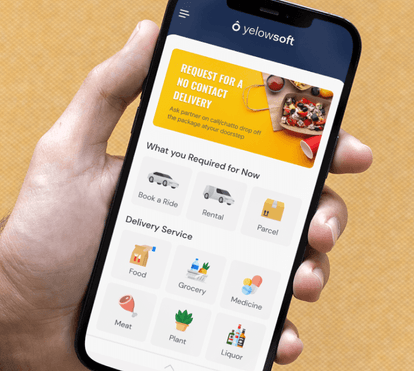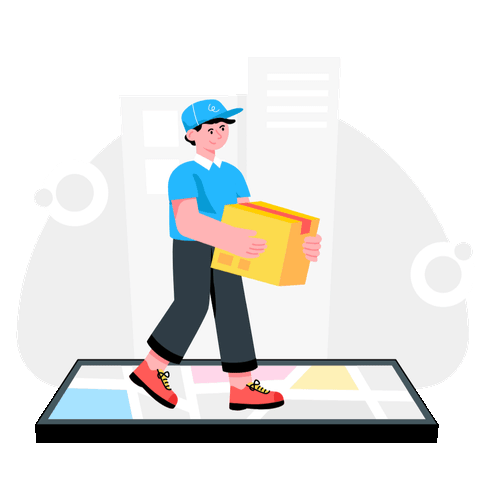Every industry experiences a tipping point when things shift dramatically. The on-demand delivery industry is going through that shift right now. What worked five years ago for delivery businesses is no longer enough to stay profitable.
In 2025, the delivery space is evolving faster than ever. All delivery businesses are at a crossroads. From groceries to milk to meat and medicine, almost everything is available on demand.
Hence, customers now expect lightning-fast service, which is why delivery businesses like yours are struggling with rising costs.
On the other hand, major players like Amazon and Uber are setting new standards. If you don’t adapt to the change, you will fall behind.
So, how do you win in 2025? The answer is simple: Understand the trends, adopt the right technology, and implement strategies that ensure long-term growth.
This blog is your ultimate guide to mastering the on-demand delivery business in 2025.
Fasten your seat belt, sit straight and keep your eyes and ears open to explore all that you should know in 2025 to succeed.
The Delivery Market in 2025 – Why It’s Do or Die for Businesses
Before you jump on to the trends, let’s first see where the delivery market is going. How does the future look for the delivery businesses?
The Economy of Speed: Customers Expect Instant Gratification
Today, consumers don’t just want fast deliveries. They want instant.
According to market research, the global on-demand delivery market is projected to reach $1.5 trillion by 2025, up from $650 billion in 2020. forbes
Delivery businesses that optimize their operations and offerings for speed, efficiency, and affordability will dominate the market.
Those that fail to adapt to change and meet these expectations will lose customers to competitors who can deliver better, faster, and cheaper.
The Cost Trap: Aggregators Are Eating Profits
Many delivery businesses rely on platforms like UberEats, DoorDash, and Instacart for order fulfillment.
But here’s the harsh truth: Aggregators take 20-30% commissions on every order. Right?
It means that instead of helping local and small businesses grow, they have created a profit-making model for their earning. This makes businesses like yours struggle to make money.
Now, you might be thinking, ‘You know this already’. What’s new in it?
Well, here is the catch. You want a solution to save the 20-30% you pay to aggregators. The only way to do that is either to build your own delivery system or own your delivery system with white label delivery software like YelowXpress.
Let us see who has won and will win if you do not adapt to the change.
Who’s Winning and Who’s Losing? The Case of Independent vs. Platform-Dependent Businesses
Major players like Amazon, Walmart+, and Instacart+ are investing millions into Quick Commerce (Q-commerce) to deliver goods in under 15 minutes.
Meanwhile, small delivery businesses like yours rely solely on third-party platforms.
Against the giants, small businesses find it hard to scale and remain profitable.
Quick Summary
Delivery businesses that will leverage technology, automation, and direct-to-customer delivery platforms will win in 2025. The rest will either become consumers or will burn their heart seeing others succeed.
Next, you will read about the trends that are shaping the on-demand delivery industry in 2025.
Trends Shaping On-Demand Delivery in 2025
You might have heard many till now; however, below you will find the latest trends that are 100% going to dominate the future delivery businesses.
Keep reading to explore the trends below.
1. The 10-Minute Delivery Revolution (Q-Commerce is Here to Stay)
In 2025 and beyond, speed is everything. From ordering to delivery, customers want it all instant. Customers want their orders to be delivered within 10-30 minutes.
You might have also heard several delivery giants promising to deliver orders in the blink of an eye. (It means in less than 30 minutes.)
What you should know is “how”? Below, you will find it.
How are other delivery businesses achieving this?
- They own micro-fulfillment centers and dark stores located near high-demand areas.
- They use AI-driven logistics software that optimizes delivery routes in real time.
- They have adopted an automated warehouse technology that allows them to pick and pack orders faster than ever.
Companies like Getir, Gopuff, and Zepto are proving that ultra-fast delivery isn’t just a dream—it’s the new reality.
Next for you is the weapon you can use in 2025 and beyond to stay competitive and beat giant aggregators.
2. White-Label Delivery Platforms are Beating Aggregators
No one likes to go obsolete. Hence, every delivery business is waking up.
No one wants to pay UberEats and other delivery partners 30% of their revenue. Most of the delivery businesses are investing in white-lable delivery software so they can run their own branded ordering and delivery platforms.
This does not just allow you to launch your branded app but also saves you 30%.
YelowXpress offers ready-to-use white label delivery software.
With YelowXpress, delivery businesses like yours can:
- Keep 100% of their profits.
- Own customer data and build loyalty.
- Customize their delivery experience.
3. AI & Automation Are Now Essential, Not Optional
AI and Automation is another trend. It has become a new normal and will be a part of almost every business, especially in the delivery industry shortly.
AI is transforming the way you operate a business. From predictive analytics to automated dispatching, AI-driven delivery systems are cutting costs and improving efficiency.
Here are some of the key AI applications in delivery:
-
AI-powered route optimization software suggests the best and shortest routes to your drivers. This reduces fuel costs.
-
The automated driver dispatching system enables you to assign the order to the nearest driver based on the location.
-
The real-time analytics feature in the delivery management software allows you to predict peak demand hours.
Now that you have explored 3 trends so far, next for you is something new that you might have heard in the entertainment industry. But now it is in your delivery business too.
4. Subscription-Based Delivery is the Future of Customer Retention
Brands like Amazon Prime, Instacart+, and Walmart+ have built customer loyalty through subscription-based delivery models.
Subscription-based delivery software or model is a solution for all the small and beginner delivery business owners. They do not have to invest a massive amount of money to build software.
All they have to do is pay and use. It is also known as the pay-as-you-go model.
This model opens the door for small delivery businesses to offer on-demand delivery even when giants like Amazon Prime and Instacart+ are dominating the market.
Why does subscription-based delivery matter?
Well, it locks in the customers. Delivery businesses use it once, experience the benefit, and renew their plan again. It's like fueling a car when your tank is empty and you want to go on the road. Here is what you get with it.
- Unlimited free deliveries for a monthly fee.
- Increased repeat orders.
- Higher customer lifetime value.
The next trend is related to the environment. Surely, you might not have heard of this next trend.
5. Green Logistics: Customers Want Sustainable Delivery
According to a Google Cloud report, 66% of shoppers are now seeking out eco-friendly brands, with 55% willing to pay more for sustainable products. source
Delivery businesses that are investing in electric vehicles, green packaging (recyclable packaging bags), and carbon-neutral delivery models will win in 2025.
Pro tip: If you want to stay competitive and dominate the market, start investing in electric vehicles. Making your packaging eco-friendly will put your nature-saving identity in the hearts of your customers.
Starting to do all these now is the investment. This will result in a profit by the end of 2025. And then you just have to harvest your profit.
6. Multi-Vendor & Multi-Order Consolidation is Changing the Game
Gone are the days when delivery businesses used to entertain single orders. This was costing them like a hell.
Now they say – Why send one order at a time when batch deliveries can cut costs and increase efficiency?
Why is there a change in the game? Here is what you need to know.
-
Platforms like DoorDash and Deliveroo are using batch delivery to serve multiple customers in a single trip.
-
Smart routing software is helping delivery businesses optimize their driver assignments.
What is the takeaway for you?
The takeaway for you is straight and simple. Follow the desire of your customers. Follow the trend. Embrace these trends instead of resisting them.
Strong recommendation: Do not be in suspicion as Nokia was. The world was shifting to touch technology, and they stuck to keypads. This rigid attitude and resistance to change threw them out of the market.
Lesson for you: Do not say NO to trends and future-ready changes. Or else, customers will say NO to you.
Finally, you have discovered the trends. Next, you will read about technologies that are transforming the on-demand delivery industry.
Keep reading to explore which technology you can use to grow your business.
Essential Technologies Transforming On-Demand Delivery

Technology is the backbone of the modern delivery ecosystem. With rising customer expectations, you must leverage AI, automation, and real-time tracking for your delivery business.
Below, you will discover the 6 game-changing technologies that are revolutionizing how delivery companies are managing and scaling their delivery operations.
1. AI-Powered Route Optimization & Automated Dispatching
AI-driven route optimization is helping delivery businesses reduce fuel costs, optimize delivery times, and improve driver efficiency.
With AI, you can automatically assign the order to the nearest driver. This minimizes idle time. The driver app with your driver suggests the fastest route based on real-time traffic data.
2. White-Label Delivery & Ordering Software
Almost every delivery business relying on third-party aggregators wants to save their 305 commission.
Many delivery businesses are already moving away from them. They are adopting white label delivery software so they can own their customer data, avoid high commission fees (almost 30%), and build their own brand identity.
Pro tip: Solutions like YelowXpress empower delivery businesses to run their own delivery network with full control.
3. Predictive Analytics & Demand Forecasting
Predictive analytics helps you anticipate peak order times, optimize inventory, and prepare for demand spikes.
Companies like Domino’s and FedEx use AI-powered demand forecasting to streamline operations and minimize delivery delays.
What can you use to predict demand forecasting?
You can implement a delivery management system that has an inbuilt reports and analytics feature. This feature will give you the same insights as Domino’s and FedEx get from their software.
4. Autonomous & Drone-Based Delivery
Companies like Amazon and Starship Technologies are investing in self-driving delivery robots and drones. The aim is to make deliveries faster and contactless (robot to human).
To increase your delivery business efficiency, you should opt for autonomous vehicles and drones.
This technology reduces human dependency and labour costs, eliminates human error, and improves last-mile efficiency.
The next technology that is shaping the delivery industry is real-time tracking. The technology is not new, but it needs some smart and advanced functionality that not all tracking software provides.
5. Real-Time Tracking & Customer Transparency
These days, customers demand real-time visibility of their orders.
Instacart+, Dominos, FedEx and several other delivery companies provide live tracking on order status, estimated arrival times, and driver location. This functionality and transparency builds trust and improves customer satisfaction.
If you implement the real-time tracking software in your delivery business, you can enhance transparency, reduce failed deliveries, and improve operational efficiency.
Finally, the last technology of this blog is cloud-based multi-vendor delivery. Cloud does not mean the real cloud. It’s a technology that can help you grow drastically. Let’s explore it below.
6. Cloud-Based Multi-Vendor Delivery Management
Being a human and a single owner, managing multiple locations or vendors manually is inefficient and tough as well.
But the cloud-based delivery management software allows you to streamline your delivery business operations, automate dispatching, and centralize order tracking across all service areas.
This cloud-based delivery management software helps in order synchronization, ensuring faster fulfillment, fewer errors, and better coordination between vendors, drivers, and customers.
The takeaway for you is:
Do not consider technology as just a luxury. Embrace it, as it is now a necessity to even perform your smallest delivery business task. Technology has become the backbone of many delivery businesses. And it is for you, too, to run a scalable and profitable delivery business in 2025.
Till now, you have explored the latest statistics, the trends, and the technology that will help you stay in the market and grow in 2025.
But you are still unaware about how to implement all these strategically? Below, you will find the winning strategies that will help you dominate the on-demand delivery market.
6 Winning Strategies to Dominate the On-Demand Market
After reading the above content, you now know that the businesses that adapt, innovate, and optimize their delivery models will thrive in 2025.
From owning customer relationships to reducing delivery costs with AI, smart strategies will separate winners from those struggling to keep up.
These six proven approaches will help you dominate the market.
1. Own Your Customers – Stop Paying High Commissions to Aggregators
If you’re still relying on UberEats, DoorDash, or Instacart, you’re handing over a huge chunk of your revenue.
The solution?
Switch to a ready to use white-label ordering and delivery platform.
By launching your own branded delivery software, you:
- Eliminate aggregator commissions.
- Take full control of pricing, promotions, and customer relationships.
- Create a seamless experience with direct customer engagement.
2. Use AI to Reduce Costs & Increase Speed
The next strategy is to use AI. AI-powered dispatching and route optimization can cut delivery times by 30% and fuel costs by up to 20%.
Smart businesses like Walmart+ and several others are investing in AI-driven solutions to:
- Assign the nearest driver instantly to reduce wait times.
- Optimize delivery paths to avoid traffic and reduce delays.
- Forecast demand and ensure optimal staffing levels during peak hours.
The next strategy is to implement subscription-based delivery business models.
3. Implement Subscription-Based Delivery for Consistent Revenue
There are 2 types of subscription-based delivery models.
One is for your delivery business, and the other is for your customers.
Brands like Instacart+ have already mastered this model. They offer customers both the pay-per-delivery option and a subscription for unlimited deliveries.
On the other hand, you, as a delivery business owner, can get the software on a subscription model. YelowXpress, the on-demand delivery software provider, offers a ready-to-use white label SaaS-based delivery management software on a subscription price.
They also call it a pay-as-you-go pricing model. It means you only pay for what you use.
Benefits of a subscription-based delivery program:
- Increases customer retention by encouraging repeat orders.
- Create a predictable revenue stream with monthly fees.
- Improves brand loyalty as customers feel like they’re getting a deal.
4. Optimize Last-Mile Logistics for Faster Service
Last-mile delivery is the most expensive and complex part of logistics. If you optimize your last-mile delivery strategy, you will win the game in 2025.
Here is how you can improve the last-mile efficiency:
- Use AI-driven dispatching to cut delays.
- Implement smart order batching for fewer delivery trips.
- Offer real-time tracking for customers to reduce failed deliveries.
5. Adopt Sustainable Delivery Practices to Attract Eco-Conscious Customers
Sustainability is not just a trend. It is an expectation. Many delivery businesses are facing loss, and several are on the verge of closing their venture who have failed to adopt ‘green logistics’.
Remember that going green and adopting sustainable delivery practices will attract eco-conscious customers to you. Plus, you will have a unique identity in the market.
What should you do to go green?
You should:
- Use electric delivery bikes, scooters, and vans.
- Offer biodegradable packaging.
- Partner with carbon offset programs to neutralize emissions.
Now comes the last winning strategy that has been very helpful for the delivery businesses operating in multiple locations. Especially for the large delivery companies.
6. Leverage Multi-Order Delivery Systems to Cut Costs
Develiry businesses waste thousands of dollars every month on inefficient deliveries.
Every delivery business knows that every mile driven for delivery costs money.
Smart multi-order delivery software technology helps your business group make deliveries and optimize routes. This ensures fewer trips and lower expenses.
Batch deliveries and multi-order systems are the key to cutting costs and increasing profitability.
How batch deliveries help:
- Reduce the number of trips per driver.
- Increase order fulfillment per hour.
- Cut operational costs significantly.
Here is a takeaway for you:
The best businesses are proactive, not reactive. Hence, implement all these winning strategies today to ensure long-term success.
Final Thoughts: The Future is Yours to Own
The on-demand delivery industry is evolving faster than ever. Businesses that embrace new trends, leverage cutting-edge technologies, and implement scalable strategies will dominate and win the market.
Those who stick to outdated methods will be left behind.
So, what’s your next move?
- Are you ready to build your own branded delivery platform?
- Do you want to reduce costs with AI-powered logistics?
- Is it time to implement subscription-based delivery models?
The future belongs to those who take action.
Make your on-demand delivery business a hit in 2025 with YelowXpress





